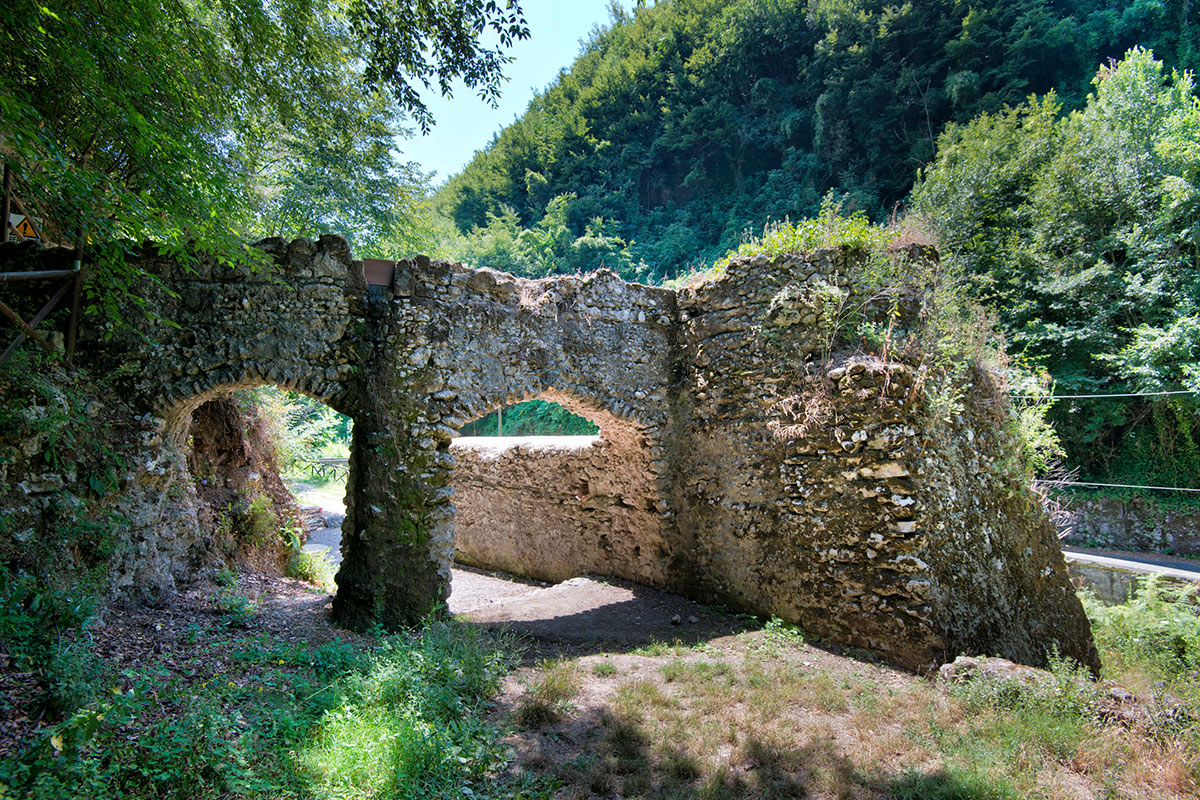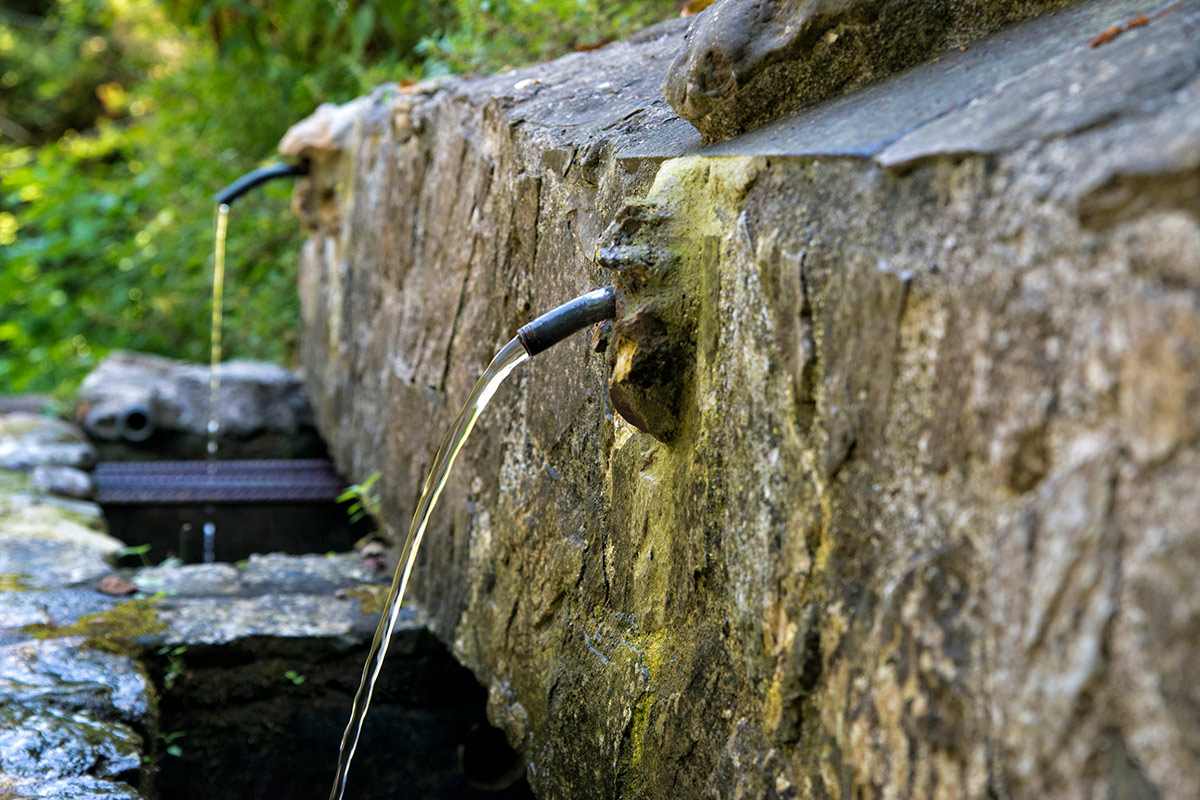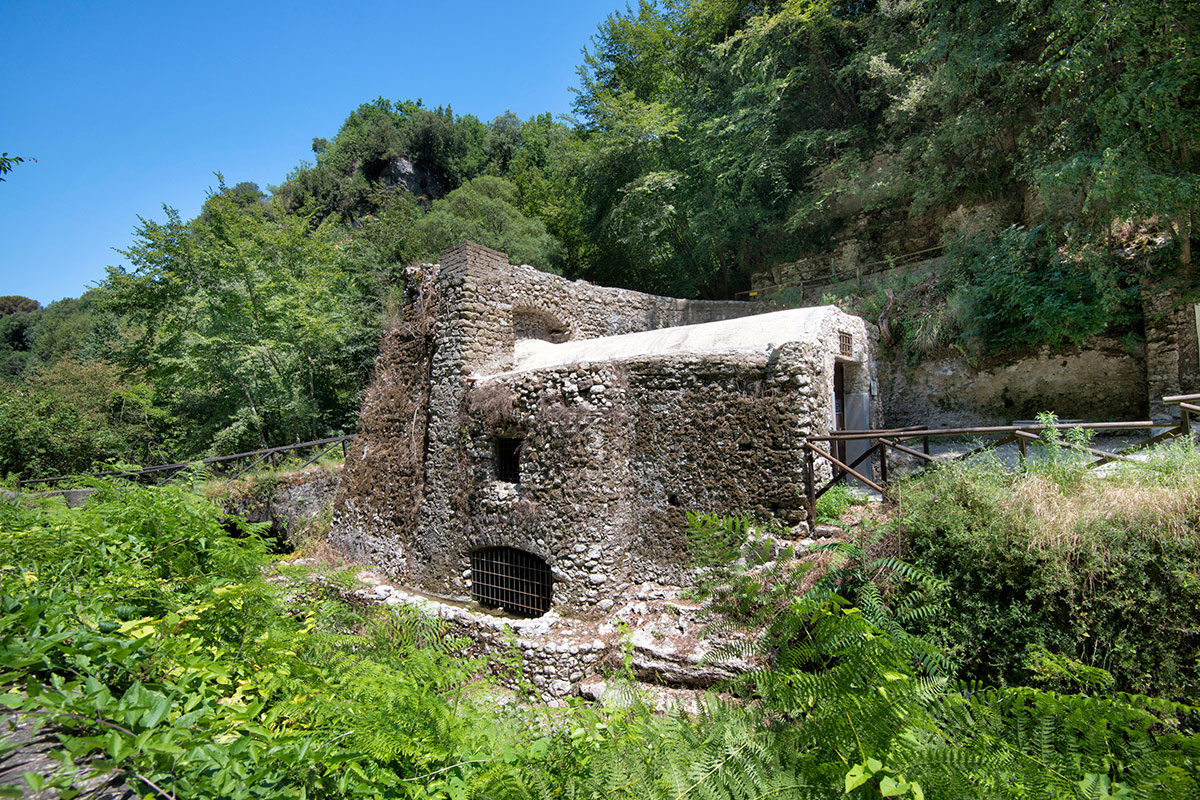It gave his name to a sparkling red wine Doc. Famous for its fabrics, anciently fruit of a thriving silkworm industry and for a modern production of swimwear. But the history of Gragnano has been specially bound to the flour for eight centuries.
 Everything started inthe middle of XIII century, in a valley nestled between MountainsLattari and crossed by a lively stream called Vemotico, not far from the hamlet of Gragnano, growing around the mighty castle built from the Amalfitans to defend the dukedom in its time of maximum brilliance. In that valley, thirty mills were built over the course of a few decades, which were using the presence of water to work and benefited the close mule track connecting Gragnano and Castellammare di Stabia, whose dock was used to ship most of the grain processed in the Mills’ Vale and once turned into flour was exported to Naples,following the same route.
Everything started inthe middle of XIII century, in a valley nestled between MountainsLattari and crossed by a lively stream called Vemotico, not far from the hamlet of Gragnano, growing around the mighty castle built from the Amalfitans to defend the dukedom in its time of maximum brilliance. In that valley, thirty mills were built over the course of a few decades, which were using the presence of water to work and benefited the close mule track connecting Gragnano and Castellammare di Stabia, whose dock was used to ship most of the grain processed in the Mills’ Vale and once turned into flour was exported to Naples,following the same route.
 And from the mills of Gragnano, always running thanks to a brilliant system of transformation of the water into energy, bread was assured to the city under many dominions even in the hardest phases of the history of the kingdom. But even if producing mostly wheat flour, good for bread, some mills had started working durum wheat already in the 1500s, obtaining a flour suitable for macaroni. The excellent flour, combined with the particular taste that the water from the streamVemotico gave to the dough and a favorable climate for dryingmade Pasta di Gragnano very famous very soon. It was produced by small pasta farms, spreading more and more around the hamlet surrounded by mountains, where its new production was now supplanting the one of wheat flour for bread and even the production of the traditional silk fabric. The definitive consecration to the production of pasta came in the 1800s, when large scale production started and the small family workshop left their spot to big pasta factories opened in the center of the country, where the pasta, freshly made by machinery with bronze drawing, was exposed for natural drying. The unification of Italy marked a further turning point, for now the pasta made in the small town of Lattari was exported not just in Naples, but also in cities in the north of Italy. And became so famous to deserve, along the railway that leads to Naples, a station“ad hoc”, inaugurated by king Umberto I and Margherita di Savoia, the first queen of the united Italy. The electric energy was another victory and marked a further development of what became a modern industry, thanks to which Gragnano was discovering a widespread wellbeing and a strong demographic increase. The world wars, the earthquake of 1980 and the competition from huge pasta factories reduced the amount of pasta factories and employees in Gragnano. A strong change that has however safeguarded the quality of the craftsmanship and of the raw material, the flour, with added value of stream water and the good weather.This is how Pasta City attracts its guests, for its food and wine,like the tasty “panuozzo”, and then win them with the beauty of its landscapes and particularities of its ancient hamlet that shows the remains of towers and walls of the castle, and churches with a remarkable historical and artistic heritage.Not to be missed the visit to the shining Vale of the Mills, with their suggestive ruins of ancient structures submerged by vegetation and the picturesque Crib crafted by local artisans.
And from the mills of Gragnano, always running thanks to a brilliant system of transformation of the water into energy, bread was assured to the city under many dominions even in the hardest phases of the history of the kingdom. But even if producing mostly wheat flour, good for bread, some mills had started working durum wheat already in the 1500s, obtaining a flour suitable for macaroni. The excellent flour, combined with the particular taste that the water from the streamVemotico gave to the dough and a favorable climate for dryingmade Pasta di Gragnano very famous very soon. It was produced by small pasta farms, spreading more and more around the hamlet surrounded by mountains, where its new production was now supplanting the one of wheat flour for bread and even the production of the traditional silk fabric. The definitive consecration to the production of pasta came in the 1800s, when large scale production started and the small family workshop left their spot to big pasta factories opened in the center of the country, where the pasta, freshly made by machinery with bronze drawing, was exposed for natural drying. The unification of Italy marked a further turning point, for now the pasta made in the small town of Lattari was exported not just in Naples, but also in cities in the north of Italy. And became so famous to deserve, along the railway that leads to Naples, a station“ad hoc”, inaugurated by king Umberto I and Margherita di Savoia, the first queen of the united Italy. The electric energy was another victory and marked a further development of what became a modern industry, thanks to which Gragnano was discovering a widespread wellbeing and a strong demographic increase. The world wars, the earthquake of 1980 and the competition from huge pasta factories reduced the amount of pasta factories and employees in Gragnano. A strong change that has however safeguarded the quality of the craftsmanship and of the raw material, the flour, with added value of stream water and the good weather.This is how Pasta City attracts its guests, for its food and wine,like the tasty “panuozzo”, and then win them with the beauty of its landscapes and particularities of its ancient hamlet that shows the remains of towers and walls of the castle, and churches with a remarkable historical and artistic heritage.Not to be missed the visit to the shining Vale of the Mills, with their suggestive ruins of ancient structures submerged by vegetation and the picturesque Crib crafted by local artisans.






Comments powered by CComment